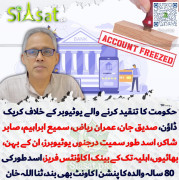Allah_Ka_Banda
Senator (1k+ posts)
Mismanagement during the Hajj pilgrimage lead to significant problems, given the scale and complexity of the event. Here are some key issues and potential strategies for improvement:
### Key Issues of Mismanagement at Hajj
1. **Overcrowding**:
- **Stampedes**: Overcrowding can lead to stampedes, which have resulted in fatalities in the past.
- **Accommodation Shortages**: Limited accommodation can result in poor living conditions for pilgrims.
2. **Transportation**:
- **Traffic Congestion**: Inefficient transportation planning can cause severe traffic jams and delays.
- **Inadequate Shuttle Services**: Lack of sufficient shuttle services between holy sites.
3. **Health and Safety**:
- **Medical Facilities**: Insufficient medical facilities and services to handle emergencies and routine healthcare needs.
- **Heat Exposure**: Pilgrims face significant risks from heat exposure and dehydration due to inadequate water and shade provisions.
4. **Logistics and Infrastructure**:
- **Sanitation**: Poor sanitation facilities can lead to health hazards.
- **Communication**: Ineffective communication can result in confusion and misinformation among pilgrims.
5. **Security**:
- **Crowd Control**: Inadequate crowd control measures can lead to chaos and increased risk of accidents.
- **Emergency Response**: Delayed or uncoordinated emergency response to incidents.
6. **Cultural and Language Barriers**:
- **Language Support**: Lack of language support services for non-Arabic-speaking pilgrims.
- **Cultural Sensitivity**: Insufficient training of staff on cultural sensitivities and needs of diverse pilgrims.
### Strategies for Improvement
1. **Advanced Planning and Coordination**:
- **International Collaboration**: Work with international bodies and countries to plan and manage pilgrim logistics.
- **Technology Integration**: Utilize advanced technologies like AI and IoT for real-time monitoring and management of crowds.
2. **Infrastructure Development**:
- **Expand Facilities**: Increase the number and quality of accommodation, medical facilities, and sanitation services.
- **Transportation Systems**: Develop and implement efficient transportation systems, including high-capacity shuttle services.
3. **Health and Safety Measures**:
- **Medical Preparedness**: Ensure adequate medical facilities and emergency response teams are available.
- **Heat Mitigation**: Provide sufficient water stations, shaded areas, and cooling systems.
4. **Effective Communication**:
- **Multilingual Support**: Provide information and support in multiple languages.
- **Information Dissemination**: Use digital platforms, apps, and social media to disseminate important information and updates.
5. **Crowd Management**:
- **Smart Surveillance**: Use surveillance cameras and drones to monitor crowd movements and prevent bottlenecks.
- **Training**: Train security personnel and volunteers in crowd control techniques and emergency response.
6. **Enhanced Security**:
- **Comprehensive Security Plans**: Develop detailed security plans covering all aspects of the pilgrimage.
- **Emergency Drills**: Conduct regular emergency drills to ensure preparedness for any incidents.
7. **Pilgrim Education**:
- **Pre-Travel Briefings**: Provide comprehensive pre-travel briefings on what to expect and how to stay safe.
- **On-Site Guidance**: Offer on-site guidance and support through volunteers and trained staff.
8. **Feedback Mechanisms**:
- **Post-Hajj Surveys**: Conduct surveys to gather feedback from pilgrims and identify areas for improvement.
- **Continuous Improvement**: Use feedback to make continuous improvements in the management of future Hajj pilgrimages.
By addressing these issues with a strategic, technology-driven approach and focusing on continuous improvement, the management of Hajj can be significantly enhanced, ensuring a safer and more fulfilling experience for pilgrims.
### Key Issues of Mismanagement at Hajj
1. **Overcrowding**:
- **Stampedes**: Overcrowding can lead to stampedes, which have resulted in fatalities in the past.
- **Accommodation Shortages**: Limited accommodation can result in poor living conditions for pilgrims.
2. **Transportation**:
- **Traffic Congestion**: Inefficient transportation planning can cause severe traffic jams and delays.
- **Inadequate Shuttle Services**: Lack of sufficient shuttle services between holy sites.
3. **Health and Safety**:
- **Medical Facilities**: Insufficient medical facilities and services to handle emergencies and routine healthcare needs.
- **Heat Exposure**: Pilgrims face significant risks from heat exposure and dehydration due to inadequate water and shade provisions.
4. **Logistics and Infrastructure**:
- **Sanitation**: Poor sanitation facilities can lead to health hazards.
- **Communication**: Ineffective communication can result in confusion and misinformation among pilgrims.
5. **Security**:
- **Crowd Control**: Inadequate crowd control measures can lead to chaos and increased risk of accidents.
- **Emergency Response**: Delayed or uncoordinated emergency response to incidents.
6. **Cultural and Language Barriers**:
- **Language Support**: Lack of language support services for non-Arabic-speaking pilgrims.
- **Cultural Sensitivity**: Insufficient training of staff on cultural sensitivities and needs of diverse pilgrims.
### Strategies for Improvement
1. **Advanced Planning and Coordination**:
- **International Collaboration**: Work with international bodies and countries to plan and manage pilgrim logistics.
- **Technology Integration**: Utilize advanced technologies like AI and IoT for real-time monitoring and management of crowds.
2. **Infrastructure Development**:
- **Expand Facilities**: Increase the number and quality of accommodation, medical facilities, and sanitation services.
- **Transportation Systems**: Develop and implement efficient transportation systems, including high-capacity shuttle services.
3. **Health and Safety Measures**:
- **Medical Preparedness**: Ensure adequate medical facilities and emergency response teams are available.
- **Heat Mitigation**: Provide sufficient water stations, shaded areas, and cooling systems.
4. **Effective Communication**:
- **Multilingual Support**: Provide information and support in multiple languages.
- **Information Dissemination**: Use digital platforms, apps, and social media to disseminate important information and updates.
5. **Crowd Management**:
- **Smart Surveillance**: Use surveillance cameras and drones to monitor crowd movements and prevent bottlenecks.
- **Training**: Train security personnel and volunteers in crowd control techniques and emergency response.
6. **Enhanced Security**:
- **Comprehensive Security Plans**: Develop detailed security plans covering all aspects of the pilgrimage.
- **Emergency Drills**: Conduct regular emergency drills to ensure preparedness for any incidents.
7. **Pilgrim Education**:
- **Pre-Travel Briefings**: Provide comprehensive pre-travel briefings on what to expect and how to stay safe.
- **On-Site Guidance**: Offer on-site guidance and support through volunteers and trained staff.
8. **Feedback Mechanisms**:
- **Post-Hajj Surveys**: Conduct surveys to gather feedback from pilgrims and identify areas for improvement.
- **Continuous Improvement**: Use feedback to make continuous improvements in the management of future Hajj pilgrimages.
By addressing these issues with a strategic, technology-driven approach and focusing on continuous improvement, the management of Hajj can be significantly enhanced, ensuring a safer and more fulfilling experience for pilgrims.


































